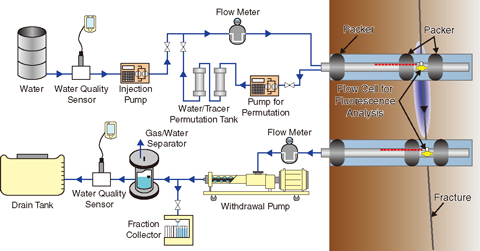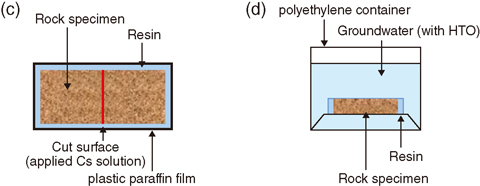
Fig.8-17 Schematic view of the in situ dipole tracer migration test

Fig.8-18 Breakthrough curve obtained from the dipole migration tests and fitting curves

Fig.8-19 Schematic view of non-steady diffusion tests
Mass transport through fractures and porous media in groundwater is accompanied by dispersion, diffusion, and sorption. It is important for high-level radioactive waste disposal to develop evaluation techniques for the mass transport characteristics. In situ and laboratory tests were conducted to evaluate the mass transport of cesium (Cs) and uranine in the Wakkanai Formation consisting of siliceous mudstone, which is porous and fractured rock mass.
In situ dipole tracer migration tests were conducted to elucidate migration processes such as sorption onto the surface of a fracture and flow channel in the fracture at the 250 m gallery of the Horonobe Underground Research Laboratory (URL). A solution using a non-radioactive tracer is injected into the injection borehole, and is then sampled from the withdrawal borehole to determine the tracer concentration to obtain the breakthrough curves (Fig.8-17). The curves shown in Fig.8-18(a) indicate that the peak concentration of Cs is much smaller than that of uranine, suggesting that the Wakkanai Formation has high sorptive properties for Cs. The breakthrough curves also indicate that the Wakkanai Formation has a large dispersivity for Cs. This large dispersivity suggests that a minute amount of Cs ions sorbed onto the fracture are partially desorbed and arrived later. In addition, the result of the in situ dipole tracer migration test is well described by the dual-channel model (Fig.8-18(b)) compared with the single-channel model (Fig.8-18(a)), suggesting that two channels of flow exist in the fracture.
A non-steady diffusion test was conducted to elucidate the sorptive properties in the rock matrix of the Wakkanai Formation using rock samples from the Horonobe URL (Fig.8-19). The apparent diffusivities for Cs (2.9 × 10−12 m2/s) and tritium (HTO) (3.4 × 10−10 m2/s) were obtained. The sorption coefficient for Cs (488 mℓ/g) was also obtained by the sorption test using powdered rock samples. It was also confirmed that the Wakkanai Formation has high sorptive properties for Cs, as suggested by the results of the in situ dipole tracer migration tests. We planned to integrate the data and knowledge obtained from further combined in situ and laboratory tests to develop evaluation techniques for the mass transport characteristics with high reliability.